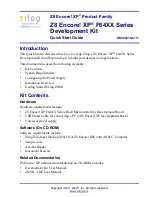16.3.2.17 Single Data-link with External Driver
Some communication schemes, such as RS-485 rely on an external driver. Here, the driver has an extra input which enables it, and
instead of tristating the transmitter when receiving data, the external driver must be disabled.
This can be done manually by assigning a GPIO to turn the driver on or off, or it can be handled automatically by the USART. If AU-
TOCS in USARTn_CTRL is set, the USn_CS output is automatically activated a configurable number of baud periods before the trans-
mitter starts transmitting data, and deactivated a configurable number of baud periods after the last bit has been transmitted and there
is no more data in the transmit buffer to transmit. The number of baud periods are controlled by CSSETUP and CSHOLD in
USARTn_TIMING. This feature can be used to turn the external driver on when transmitting data, and turn it off when the data has been
transmitted.
The timer,
, can also be used to configure CSSETUP and CSHOLD values between 1 to 256 baud-times by using
TCMPVAL0, TCMPVAL1, or TCMPVAL2 for the TX sequencer.
USn_CS is immediately deasserted when the transmitter becomes disabled.
Figure 16.10 USART Half Duplex Communication with External Driver on page 462
shows an example configuration where USn_CS is
used to automatically enable and disable an external driver.
USART
RX
TX
µC
CS
Figure 16.10. USART Half Duplex Communication with External Driver
The USn_CS output is active low by default, but its polarity can be changed with CSINV in USARTn_CTRL. AUTOCS works regardless
of which mode the USART is in, so this functionality can also be used for automatic chip/slave select when in synchronous mode (e.g.
SPI).
16.3.2.18 Two Data-links
Some limited devices only support half duplex communication even though two data links are available. In this case software is respon-
sible for making sure data is not transmitted when incoming data is expected.
TXARXnEN in USARTn_TRIGCTRL may be used to automatically start transmission after the end of the RX frame plus any TXSTDE-
LAY and CSSETUP delay in USARTn_TIMING. For enabling the receiver either use RXENAT in USARTn_TXDATAX or RXATXnEN in
USARTn_TRIGCTRL.
EFM32JG1 Reference Manual
USART - Universal Synchronous Asynchronous Receiver/Transmitter
silabs.com
| Smart. Connected. Energy-friendly.
Preliminary Rev. 0.6 | 462


















